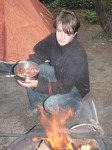Although I love the outdoor skills we teach at Wolf Camp and the Conservation College, the actual skill of teaching is my real specialty. Teaching in the classroom is difficult enough, where walls and rows of tables and chairs help keep students focused. Outdoors, it’s a real trick helping students learn efficiently, and to avoid developing bad habits that can come back to haunt you and them later. – Chris Chisholm
 Teaching: It’s All In The Prep
Teaching: It’s All In The Prep
If you want to create excellent classes and other forms of educational programming, outdoors or otherwise, the key is preparation. Prep time is the same no matter how many times you have taught something in the past. What you prep varies, however, depending on whether it’s the first time, the second, third or ten thousandth time you teach something.
If you teach for the first time, your prep should focus on developing “community” with your group. Until you establish a sense of community, i.e. a positive mental and emotional connection, a feeling of safety with rules and boundaries, you won’t be able to teach any subject matter. Preparation in regards to the subject matter should focus on how to present an outline or overview of the subject in a way that makes it intriguing so the students look forward to learning it later – read below for tips on that.
If you are a veteran teacher, or if you are teaching the same material a hundred times to different sets of students, your prep time should include a review and improvement on how the student community environment is doing. The bulk of your prep time can then focus on how to keep the material fresh – not something you needed to do the first time or two you taught it because back then, the students could just sense your excitement for it. Now you need to work on freshness. Study it more, push yourself and your students to learn more. Give them more, and their love for the subject will grow.
Something that has always fascinated me is that the first time I teach a program, it’s like magic. Call it beginner’s luck, or that your angels are right there with you. The second time, if you don’t prep much, it goes fine, like your angels are giving you a chance, but you’ll only win 4 stars from your students. The third time, if you don’t prep, things go bad. Sounds metaphysical, but in my experience, it’s a fact of nature. Go do something other than teaching if you can’t discipline and humble yourself to prepare every time to be the best of teachers.
Creating Safe Teaching Environments: Physical, Mental & Emotional
The bulk of the Conservation College mission, vision and guiding principles revolves around the creation of safe teaching environments. The physical, emotional, mental, spiritual and social health of students is our top priority. We expect students of all ages to seek their truth, develop self-sufficiency, respect hazards, strive for success, be emotionally sensitive, express art and music, improve physical health, honor their own religion or spirituality, be tolerant of differences between people, and recognize similarities among everyone on earth. Some of the highlights we, and all good teachers, strive to achieve include:
- Safe learning environments through effective risk management including solid trip preparation and emergency response protocol.
- Fun and collaborative working environments based on healthy staff, clear policies, and a dedication to teamwork.
- Courteous, responsive, and professional conduct with all students and family, honoring every individual for unique skills, talents, beliefs and contributions.
- Profound experiences and challenges that result in the maturation of students, real confidence and self-reliance, deeper understanding of self, greater love of nature, and a respect for the ethic of conservation.
- Good role modeling for peer and life mentoring at programs in order to nurture the success of every student.
Achieving the above goals demonstrates the reason people should get good teaching and educational administrative degrees. Unfortunately, most of the practical stuff on how to achieve those goals isn’t taught in college. You learn it on-the-job since learning to teach is a life-long pursuit, so maybe there’s no way to learn how to do it in college – you just have to keep practicing, solving challenge after challenge, assessing what happened, prepping some more, then doing it again. Eventually, you’ll need to learn how to deal with everything, including:
- Recognizing & Addressing Homesickness
- Teaching to Students with English as a Second Language
- Hearing Loss, Visual Impairment & Physical Limitations
- Weight Disorders, Signs of Trauma, Abuse, Grief & Loss
- Sexual Harassment, Bullying & Co-Dependence
- Culture, Class, Religious, Lingual & Familial Sensitivities
- Poverty & Foster Issues, Attitudes of Privilege & Prejudice
- Sexual Orientation & Gender Identities
- Religious, Ethnic, Lingual & Other Sub-Cultural Identities
- Mental Illnesses (Treatable & What You’re Unable To Serve)
- Developmental Delays (Physiological), Learning Impairments (Dyslexia Etc)
- ADD & ADHD, OCD, Verbal & Nonverbal Learning Disorders
Respect for Teacher & Student
To start, focus on a couple of things you’ll need to prepare right away. Every teacher knows that you must establish authority first thing, rather than trying to be “liked” by students. The best classroom teachers are often despised on the first day for being “strict” while the “coolest” teachers on the first day end up with a mess later on, teaching very little over the long run. Miraculously, the “strict” teachers magically become “cool” by the second week of school, able to impart challenging and exciting material.
This trick of the trade is more of a trick when you are teaching a “one-off” class – a short outdoor program, for instance. So, the very first time any student makes a peep out-of-turn, or moves an inch from where they are supposed to be, make a quick example of them. I like to put my hand on their shoulder, explain at the appropriate distance from their face in a compassionate but strict way, that “what you are about to learn is critical for the safety and success of every person here, so we don’t even have a second to waste on distracting talk; we’re wasting this 30 seconds of time now telling you how important it is to follow every single normal school-like rule so that we can go as far as humanly possible in learning everything we can possibly cover in this one (hour, day, week).”
The above trick pretty much takes care of any future problem not listed above, but if not, then here’s how you deal with oppositional behavior: -flect it! Remember, either you never created a successful sense of community, i.e. gave clear and consistently-enforced rules, or you and/or your student are not recognizing that one of the above bullet-point problems exists. Always assume you are missing something, and follow these steps to deal with an oppositional challenge to your leadership.
1. Inflect your voice in new ways that help students follow the rules better, and always be totally consistent with appropriate consequences, or your students will never respect your word (click on the next article in this series for age-appropriate consequence ideas). For example, say “I never said she stole my money” out loud 7 times, but inflecting a different one of the words each time (a common training exercise with unknown origin after lengthy internet search). Now try it with the sentence “If you speak before I call on you again today, you will be the last person I allow to speak for the rest of the day.”
2. Failing that, deflect. Deflect the behavior, especially with teenagers, until you recognize what the problem is, but not long because then you’ll never reel them back in. Maybe the teen is just hungry, thirsty, or tired. Express compassion and without letting them know why you are doing it, provide a short break, and feed them if necessary. Remember to HALT: Hungry? Angry? Lonely? Thirsty? or Hurting? Alienated? Loving? or Tired?
3. Finally, reflect! If you can’t figure out what you did wrong, or what is causing your student to be oppositional, then keep going back to #1 and #2 until class is over, and before you see your student again, reflect and prepare a positive solution for the first time it happens again.
Continue to Teaching Nature Part II – Learning Styles & Age Considerations…











